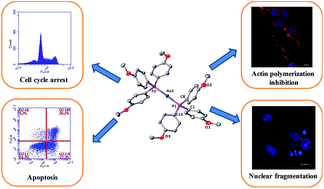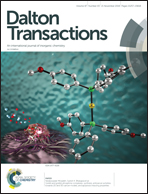Gold(i) and gold(iii) phosphine complexes: synthesis, anticancer activities towards 2D and 3D cancer models, and apoptosis inducing properties†
Abstract
A series of gold(I), gold(III) and cationic gold(I) complexes of tris(4-methoxyphenyl)phosphine and tris(2,6-dimethoxyphenyl)phosphine were synthesised and fully characterised by spectroscopic methods. The molecular structures of selected complexes were also determined by X-ray diffraction analysis. The prepared complexes [AuX{P(C6H4-4-OMe)3}] [X = Cl (1), Br (2), I (3)], [AuCl3{P(C6H4-4-OMe)3}] (4), [Au{P(C6H4-4-OMe)3}2]PF6 (5), [AuX{P(C6H3-2,6-{OMe}2)3}] [X = Cl (6), Br (7), I (8)], [AuCl3{P(C6H3-2,6-{OMe}2)3}] (9) and [Au{P(C6H3-2,6-{OMe}2)3}2]PF6 (10) were investigated for their anticancer activity against five human tumor cell lines [ovarian (SKOV-3), fibrosarcoma (HT1080), glioblastoma (U87MG), prostate (PC-3), and cervical (HeLa)] as well as against 3D spheroidal models of HeLa cells. The cationic complex 10 was found to exhibit a remarkably broad spectrum of anticancer activity with approximately 30-fold higher toxicity than cisplatin against PC-3 and U87MG cancer cells; this complex also showed the strongest inhibition of spheroid growth in 3D models of HeLa cells. The mechanism of anticancer activity of these gold complexes was found to be strong inhibition of thioredoxin reductase, increased ROS production and subsequent apoptosis induction as evidenced by the sub G1 cell accumulation, DNA fragmentation, and caspase-3 activation.



 Please wait while we load your content...
Please wait while we load your content...